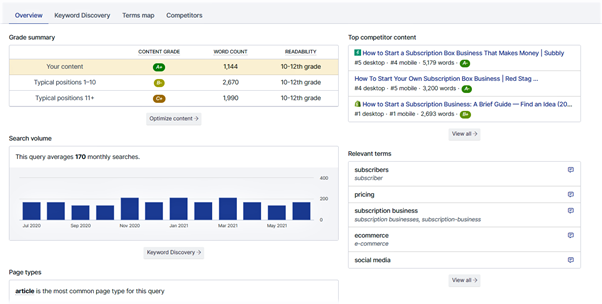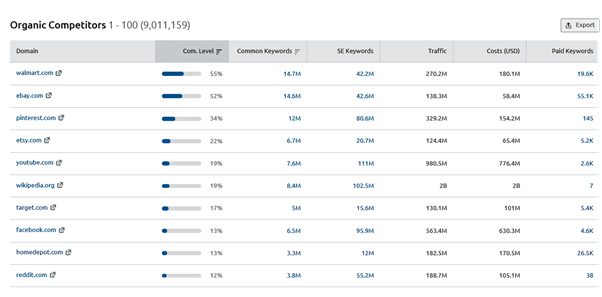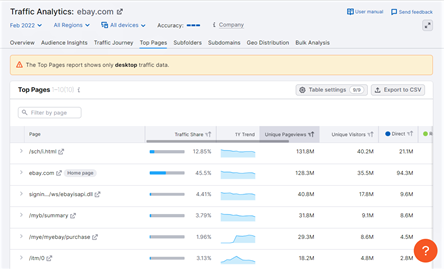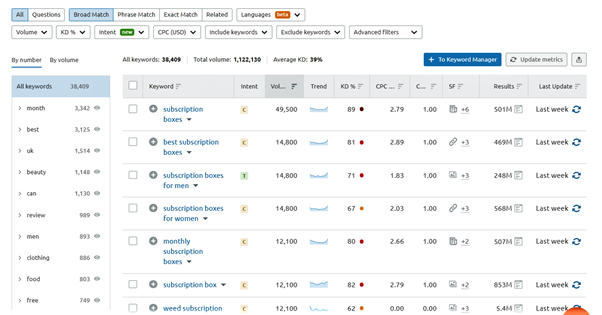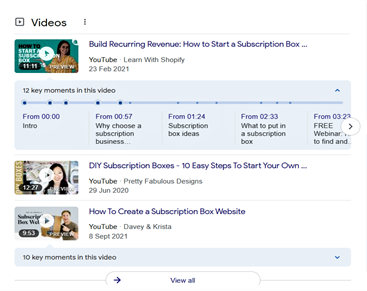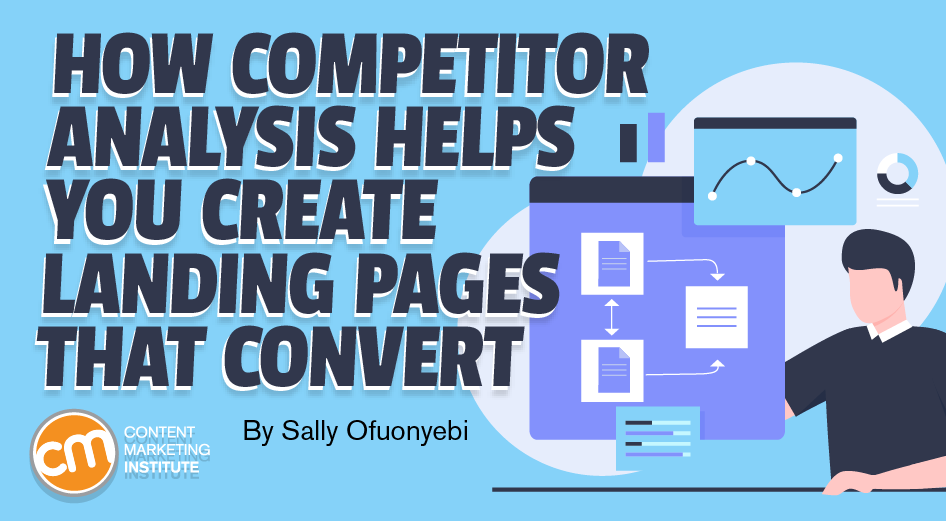
How do you create a landing page that beats your competitors’?
Look at what they’re doing – after all, that’s what buyers do.
A competitor analysis can help you learn their strong points and identify their weaknesses to improve conversion rates. These nine SEO and content marketing experts share their tips for evaluating what your competitors do to inform your company’s landing page development.
Your customers are looking at your competitors’ landing pages. Shouldn’t you, asks Sally Ofuonyebi via @CMIContent. Click To Tweet
1. Brainstorm, research, and compare
Rebekah Edward, CEO at SEO agency Clara, says her research process starts with the target customer: What would they be looking for? What things would they like to see?
“I’ll Google terms that come to mind and proceed to analyze landing pages that are ranking on the SERP to see if I locate any that is close to what I’m looking for,” she says.
Then, she uses Ahrefs’ Site Explorer tool, which looks at the organic search traffic and link profile of any URL. “I reverse engineer the keywords most relevant to my own landing page. From there, I look to the top five pages ranking for those keywords – and that’s where the real competitor research begins,” Rebekah says.

Using a combination of Ahrefs and SimilarWeb, Rebekah looks at their:
- Visitor demographics
- Traffic breakdown (ads, organic, social, etc.)
- List of competitors from SimilarWeb to add any she hasn’t already found
She also runs her target keywords through Clearscope to generate latent semantic indexing (LSI) keywords that her competitors use on their pages about a similar product/service. It includes an overall content grade based on ranking positions, relevant terms, search volume, page types, and top competitor content:
Click to enlarge
She says the most effective thing she does is look at the competitor landing pages side by side on both mobile and desktop and jot down her observations.
Look at competitor landing pages side by side on mobile and desktop. Jot down your observations, says @leadinsideout via @CMIContent. Click To Tweet
2. Make sure you have the right audience
Christopher Penn, co-founder and chief data scientist at Trust Insights, shares his thoughts on how to create landing pages using competitor analysis in this video:
- Have you got the right audience?
- Do you have the right offers for your audience?
- Is the creative good?
Note that the question about the creative is the last one. He says you should resist the temptation to leap into creative optimization until you’re sure you have the right audience and your offer is relevant to them. To know those answers, do in-depth research into and with your audience – run focus groups, do surveys, and conduct one-on-one interviews.
Then, scrutinize competitors’ landing pages and offers. What are they offering? Are they giving discounts? Do they offer free shipping? What button colors do they use? What’s their customer experience like? What kinds of images do they use to support their content?
Then, use social analytics and landscape monitoring tools to find out what your target audience is saying about competitor brands. For e-commerce brands, you can check Amazon reviews, and B2B marketers can look for reviews and ratings on Capterra and G2, among others.
You also can use software like Google Marketing Platform’s Optimize to deliver engaging customer experiences through A/B testing and website personalization.
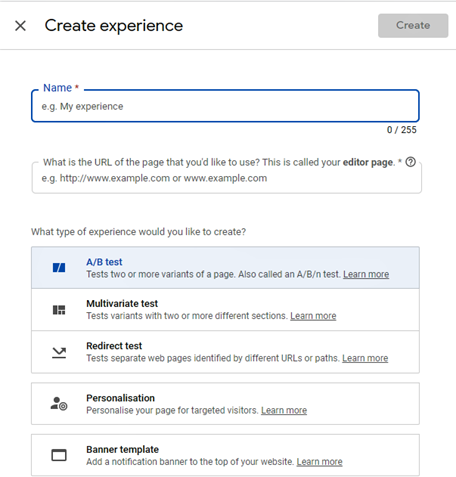
HANDPICKED RELATED CONTENT:
3. Engage with your competitors
To get clearer on what your competitors are doing, you need to interact with them. Take note of both direct and indirect competitors – businesses that sell the same service as you and others who fulfill the same need or solve the same problem.
On the Semrush dashboard, click Domain Overview to enter a domain name and see your competitors and related data:
Click to enlarge
Click on view details under Main Organic Competitors to see the list of your keyword competitors.
Click to enlarge
Claire Beveridge, freelance blog manager at ConvertKit, advises using burner email – not your company’s – and taking their landing pages and subsequent onboarding experience for a spin. Note factors like:
- UX experience: Is the site easy to navigate? What colors are they using? What’s their font choice?
- Messaging strategy: What language do they use on buttons? What’s their call-to-action strategy? Are they using images or video?
- Trust strategy: What trust icons or testimonials do they include to improve brand credibility and increase conversions?
- Onboarding friction: What snags did you find in their signup process that you can avoid on your landing pages?
- Tech stack: Are they using tools that prompt more conversions that you don’t? For example, a competitor accepting crypto payments when you’re not could affect your conversions.
- Analyze their traffic: Do they see more success from social or pay-per-click campaigns or organic? For example, if your competitors landing pages get zero traffic from PPC campaigns, there’s likely no need to waste your ad budget running one.
In Semrush, click Traffic Insights from the dashboard to identify where this traffic is coming from—channels (and the breakdown of these) and countries. It will look like:
Click to enlarge
Set up a burner email account and engage with your competitor through their landing page to better understand the customer experience, says @Cbeveridge via @CMIContent. Click To Tweet
Understanding these elements should inform the creation of your landing pages to increase prospect engagement.
4. Research competitors’ keywords further
SEO consultant Nick LeRoy uses a pillar content approach to his landing pages. He says he’s a fan of Ahrefs and Semrush’s Keyword Magic Tool to determine seed keywords and identify which sites drive the most traffic based on the parent topics:
Click to enlarge
With this information, Nick lists critical keywords and topics to cover in the new piece of content – the pillar page.
He also encourages reviewing the results in Google search features, such as the People Also Ask section, to note related topics as well as the length of the content.
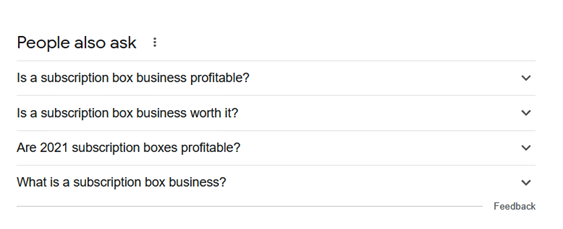
Don’t forget to include internal links in the content – a step missed by many marketers. “I do this to wrap up my pillar content,” Nick says. “Not only does internal linking help with getting your content discovered (and indexed), it also sends some much-needed internal link equity to this new page.”
Don’t forget to include internal links in your #content, says @NickLeRoy via @CMIContent. Click To Tweet
Brian Piper, director of content strategy at the University of Rochester, recommends using Semrush for keyword gap analysis to see keywords your competitors are ranking for that you’re not to get ideas for other terms to include in your landing pages.
Use @semrush for keyword gap analysis to see keywords your competitors are ranking for that you’re not, says @brianwpiper via @CMIContent. Click To Tweet
HANDPICKED RELATED CONTENT:
5. Observe commonalities in search rankings
Zoe Ashbridge, SEO strategist at Adriana Stein Marketing, usually uses an SEO angle in creating landing pages. “I want the page to rank for something specific – and rank well,” she says.
She looks up the top SERP results for her target keyword or cluster of keywords. Then, she looks for the common elements of the top-ranking content. For example, if videos appear as the top results like these for a “subscription box” search, Zoe would consider using a video on her landing page.
Click to enlarge
By modeling your content after the top-ranking results, the landing page is more likely to rank higher in SERPs.
By modeling your #content after the top-ranking results, the landing page is more likely to rank higher in SERPs, says @ZoeAshbridge via @CMIContent. Click To Tweet
6. Take cues from competitors’ spending
Ad insights are a gold mine to up your landing page game. I love how Brett Farmiloe, CEO of Terkel, explains it: “Follow the money trail.”
Visit the landing pages your competitors pay to promote. If they are spending money to drive traffic to a landing page, it is likely converting, and the advertiser has spent time perfecting it. To identify these presumed high-converting landing pages, click on a few of the sponsored results on the SERP for your keyword(s) to find some commonalities worth repeating on your page.
Visit the landing pages your competitors pay to promote, says @BrettFarmiloe via @CMIContent.
To go deeper, use tools like Ahrefs and SpyFu to determine your top competitors in the paid ad space and evaluate their pages to get insights for yours. This graphic illustrates what SpyFu details in its most profitable ads and keywords results. It includes listings of keywords based on clicks per month, cost per click, coverage, and top ads based on the keyword.
7. Get insights from non-number data
Don’t just focus on quantitative analytics. Qualitative data also can be valuable. Shayla Price, content strategist and founder of PrimoStats, says: “I’ve used qualitative data – like customer support options, platform features, integrations, and plan comparisons – to build high-converting landing pages.”
Don’t just focus on quantitative analytics. Qualitative data also can be valuable, says @shaylaprice via @CMIContent. Click To Tweet
She writes the copy to emphasize what her brand offers as it relates to what the customer needs. Sometimes, she visualizes the relationships and pinpoints gaps using a Venn diagram.
But she still relies on quantitative data, too. “I measure the effectiveness of my copy by analyzing the bounce rate, time spent on the page, scroll rate, and conversion rate,” Shayla says.
8. Write a connection-focused message
Dom Kent, director of content marketing at Mio, interviews Oliver Meakings of Roast My Landing Page about tips that make a great landing page for marketing a product. Among their recommendations:
- Know your customer persona. Don’t try to address multiple audiences or products on one page. Create a page for each of your solutions or personas.
- Collect customer feedback. What are they saying? What do they need? What are their pain points?
- Write with empathy. Let them know you feel their pain, agitate this, and introduce your product as the solution.
- Add social proof. Tell your audience why they should buy from you and not your competitors. Use customer reviews, testimonials, case studies, and client logos to build trust and credibility.
To make a great landing page: Know your customer persona, collect customer feedback, write with empathy, and add social proof, says @helloitsolly via @DomKent via @CMIContent. Click To Tweet
In this example, HubSpot uses its total customer numbers, including country locations, along with well-known brand names to establish credibility with landing-page visitors:

Use these quantitative and qualitative checklists
All this advice for a competitor analysis of landing pages can be summarized into these two checklists – a quantitative one and a qualitative one.
You will work most efficiently by tackling the quantitative list first. Analyze your competitors’ metrics – the numbers potentially affecting landing page traffic and sales. Claire, Rebekah, and Nick share this tracking list:
- Quantity of keywords the competitor ranks for
- Estimated organic search traffic to the page
- Domain authority of site
- Quantity of internal links pointing to the ranking pages
- Backlinks or external links pointing to the ranking pages
- SERP rankings
- Keywords targeted (PPC campaigns or organic)
- Share of voice – awareness of the competitor’s brand and engagement in the market
- A/B testing use
- Organic vs. paid traffic percentages
- Visit duration/time on page
- Pages per visit
- Visitor demographics
Now that you have the data to know which competitors’ landing pages are likely most successful, you can scrutinize the details of those pages. To simplify this qualitative competitor analysis, use this checklist from Claire and Rebekah:
- What CTAs are they using? Where do they appear?
- How is the page laid out?
- What creative assets are used? How?
- Does the page use reviews, testimonials, or other social proof? Are they shared as images, text, or videos? Are words or concepts repeated in the reviews?
- What about the user experience sticks out as inconvenient or clunky?
- What makes the user experience great?
- What languages, colors, and fonts are they using? Do those differ with their CTAs?
- Are they using tools to entice more conversions?
- What is the price of the product or service being sold?
- When and how do they discuss the price?
- What statistics or data are used to indicate the demand for this product or service?
- How long is the text-based content? Does it feel overwhelming or just right?
Creating a landing page requires in-depth competitor analysis, qualitative data, valuable content, and a smooth user experience.
With these tips and checklists, you can assess what your competitors are doing well and what you can do better or differently on your landing pages to drive traffic, catch audiences’ interests, and generates sales.
All tools mentioned in this article are identified by the author. If you have a tool to suggest, please add it in the comments.
Cover image by Joseph Kalinowski/Content Marketing Institute

